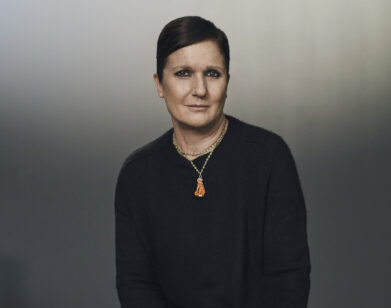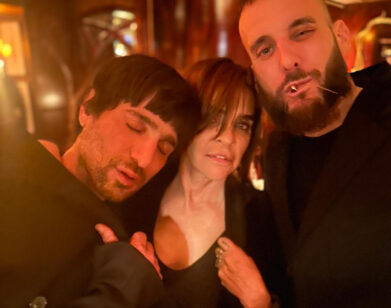CG’s Woman of Style
ALIX ANGJELI AT TEN TON STUDIOS IN NEW YORK, MAY 2015. PHOTOS: HANS NEUMANN. STYLING: KATIE BURNETT. MAKEUP: CEDRIC JOLIVET AT SEE MANAGEMENT USING MAC COSMETICS. HAIR: KAYLA MICHELE AT STREETERS USING ORIBE. STYLING ASSISTANT: LAUREN PIVEN. RETOUCHING: TATIANA CHEBOTEROVA.
“Style and luxury to me are so different,” Chris Gelinas tells model Alix Angjeli. “The first impression I ever had of style was my grandmother, who is an immigrant from Croatia and never had much money, but she always looked so put together,” he continues. “It’s not about having a lot of money to spend to have style; it’s more an energy you bring to your clothes.”
On Friday morning, Gelinas will show his Spring/Summer 2016 CG collection as part of New York Fashion Week. It’s been a very busy few seasons for the Canadian designer, who launched his eponymous label two years ago. In 2014, he was one of 12 finalists for the first-ever LVMH Young Designer Prize. This year, he is one of 10 finalists for the CFDA/Vogue Fashion Fund.
Here, Gelinas and Angjeli discuss the designer’s career to-date. A native of New York, Angjeli made her runway debut at NYFW last season as an exclusive for Calvin Klein. She has since walked for the likes of Giambattista Valli, Hermes, Rick Owens, and Versace.
ALIX ANGJELI: When did you start to become interested in fashion?
GELINAS: I always knew that I wanted to be in fashion in some capacity; I just didn’t really know quite what that was. I grew up in a pretty small town in Canada, so there weren’t exactly a ton of outlets for fashion. Then one summer while I was studying business I did an internship at Marc Jacobs. Just being part of that process and seeing a real New York sample room, I was totally hooked after that.
ANGJELI: I read that you studied fashion at Parsons. Why did you choose Parsons?
GELINAS: Parsons is one of the best schools, I think, and in terms of New York design, some really amazing designers have graduated from Parsons: Marc Jacobs, Tom Ford—there is such a long list. I was working at Marc as a buyer and trying to satisfy my business degree but still be close to the design process. Then I realized one day I was spending way more time in the sample room and the design room than in front of my computer, and I was like, “I really need to go back to school.” Parsons had a really cool associates degree program, which was perfect for me since four more years of school didn’t really seem like an option. I was already in my mid-20s at the time. So it was that right place at the right time I guess.
ANGJELI: When and why did you move to New York?
GELINAS: I moved to New York eight or nine years ago. My sister was living here at the time, which made it really easy because it was nice to be able to move in with family and we’re pretty close. But the first time I ever visited the city was a few years before that, and I never felt more at home. The energy was so intoxicating and I just felt so comfortable that I knew, somewhere down the line, I had to live here.
ANGJELI: I grew up in New York.
GELINAS: So then you know! You’ve probably seen it change a lot.
ANGJELI: For sure. Fashion has definitely progressed a lot over the last decade; it’s been insane. To have all of these new designers that are coming in—you’re obviously one of them and you’re doing such a great job—is very nice to witness, especially as a model. You get to see the backstage and what’s really happening.
GELINAS: Yeah. You guys are like flies on the wall in the fittings and in the show process. You see all sides of it: the glossy side, the intense side, the gritty side. It really must be one of the only roles where you get both sides of it in such an intense way.
ANGJELI: I tell everybody, if I ever want to do something else in life, I can definitely do something in fashion because I really know everything about it at this point. A free education! I’d really like to know who your style icon is.
GELINAS: I’ve always been really inspired by just powerful women—women who have a really strong sense of themselves. I like to think that the woman who really covets CG pieces is someone who uses fashion as only one form of their expression. She has other outlets and she’s creative and she’s substantive. The last few seasons I’ve been having more women come to the studio and working with people one on one. They range from their early 30s to their early 70s, so these are women with big differences in lifestyles, but their one common thread is that they love the art of getting dress and the transformative property of clothes, which I really try and bring into my collection. It’s hard to say there’s one particular woman I have in mind—there’s always an attitude or an energy—but I think the underlying theme is these really strong, powerful women.
ANGJELI: I’m sure you have, on your mood board, some type of woman who you design for for this season, no?
GELINAS: I was reading, last season, a Marianne Faithfull biography and I totally fell in love with her. She was seen for the first 15 or 20 years of her career as Mick Jagger’s girlfriend—this accessory to this male rock star. Meanwhile, she was so intelligent and creative. So there are a few images of her from the early ’60s that stayed on my mood board. She’s got such a cool energy. I like how she takes menswear but wears it her own way. There’s still something very feminine about her; a very empowering feeling. That’s definitely one who’s a mainstay on the mood board.
ANGJELI: Are you influenced by music as well?
GELINAS: I always have music on in the studio. I find that usually there’s always one song or something that catches my attention at the beginning of the season and I play it obsessively. Music definitely has a big part in it.
ANGJELI: I listen to music all the time—’70s music. It’s very inspiring to me. What is the point of fashion?
GELINAS: For me, it’s going back to that idea of the transformative properties of clothes. I think fashion at this level should elevate your mood and make you feel something. We all have those pieces in our closet where it’s not about utility, it’s about the dress that makes you feel a little more delicate or feminine, or that coat that makes you feel more powerful. I like the idea of transferring the energy that the designer puts into their vision, and then the wearer embodies that energy. There are elements of utility because I think so much about movement and ergonomics, but it’s really about emotion and fantasy—becoming different characters within ourselves. I think we all have these different people, these moods that we want to enhance and I think good clothes can do that.
ANGJELI: For sure. I put on clothes and my whole attitude changes. I feel like a different person. And I love that clothes can make you feel that way.
GELINAS: You feel it, but then other people notice it too. When you have those pieces that just make you float, that’s the cool part about fashion.
ANGJELI: Do you come from a creative family?
GELINAS: My grandmother was a seamstress and my grandfather was a furniture maker and upholsterer. As a kid, I didn’t see it necessarily as a creative thing, they were very about the craft and I was always playing around in their works rooms. Now, as I’m working on my own brand and starting to dig a little deeper into where my curiosity might have started with fashion and design, I realize that it was growing up in these workrooms and watching my grandparents—getting that sense of working with your hands. I’m really spoiled in the sense that I don’t have a job where I sit in front of a computer; I can get up and grab some fabric and put it on a dress form and really make something.
ANGJELI: Do you still produce your clothes in New York?
GELINAS: Yeah. It’s a really important part of the brand. Everything is made and produced in New York, and that’s something that I don’t ever envision changing. There’s a level of skill and craft that we have here and it’s such a historic thing, the Garment District. It’s really fun to be part of that renaissance.
ANGJELI: Is that where your atelier is?
GELINAS: Yes. I’m right in the heart of it. I literally rent from a factory, which has its good points and its bad. When I’m in the process of producing things, or it’s development time and we’re making things, there’s a million fires a day to put out and they are only an elevator ride or a five minute walk away, so that really helps. But it isn’t always the most romantic setting.
ANGJELI: I’m sure you can find inspiration anywhere in New York. What, if anything, would you like to change about the fashion industry?
GELINAS: So many things! I could talk for three more hours. In starting this, it was really this idea of quality over quantity and slowing down the pace in which we develop. Good ideas and good design take time, and that’s something that this industry and the calendar has really robbed from the process. It’s nice to imagine clothes that are crafted and they take time to make and they take time to sell—they’re not just in store one month, on sale the next month, and then on to the next thing. We’ve definitely trained our consumers to want and expect things to refresh as quickly as their Instagram. These things take time if they are worth it.
ANGJELI: I definitely have a few pieces in my closet that I’ve been wearing for seven years now. It’s funny how we can have so much emotion attached to a garment.
GELINAS: I think good design evolves with you. It’s not about necessarily timelessness, but it’s that quality that can resonate with you for many years, rather than I wear this dress and throw it away the next day. There’s always room for those pieces, but fashion, and luxury fashion especially, could take a lesson in dialing-down a bit and chilling out.
CHRIS GELINAS WILL SHOW HIS S/S 2016 CG COLLECTION THIS FRIDAY, SEPTEMBER 11. FOR MORE ON THE DESIGNER AND CG, VISIT HIS WEBSITE.







